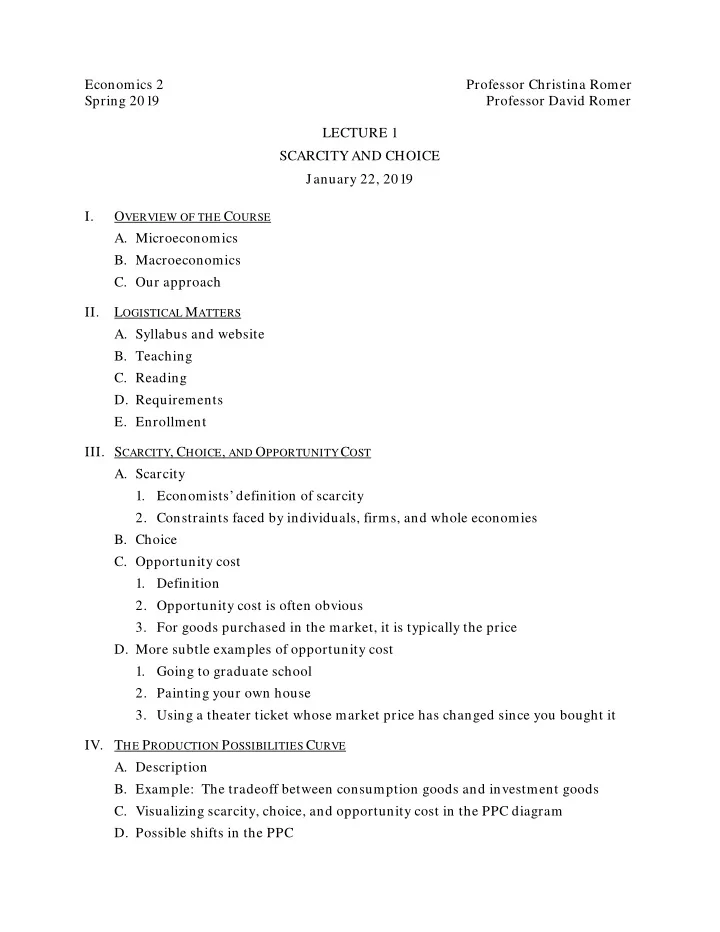

Economics 2 Professor Christina Romer Spring 2019 Professor David Romer LECTURE 1 SCARCITY AND CHOICE January 22, 2019 I. O VERVIEW OF THE C OURSE A. Microeconomics B. Macroeconomics C. Our approach II. L OGISTICAL M ATTERS A. Syllabus and website B. Teaching C. Reading D. Requirements E. Enrollment III. S CARCITY , C HOICE , AND O PPORTUNITY C OST A. Scarcity 1. Economists’ definition of scarcity 2. Constraints faced by individuals, firms, and whole economies B. Choice C. Opportunity cost 1. Definition 2. Opportunity cost is often obvious 3. For goods purchased in the market, it is typically the price D. More subtle examples of opportunity cost 1. Going to graduate school 2. Painting your own house 3. Using a theater ticket whose market price has changed since you bought it IV. T HE P RODUCTION P OSSIBILITIES C URVE A. Description B. Example: The tradeoff between consumption goods and investment goods C. Visualizing scarcity, choice, and opportunity cost in the PPC diagram D. Possible shifts in the PPC
Economics 2 Christina Romer Spring 2019 David Romer L ECTURE 1 Scarcity and Choice January 22, 2019
No Electronics Policy • Please turn off and put away all phones, laptops, and tablets.
I. O VERVIEW OF THE C OURSE
Microeconomics • Study of economic behavior at a fairly narrow level. • How individual consumers and producers make decisions; what happens in the market for particular goods; what determines the wages and employment of a particular type of worker. • Examples of microeconomic questions. • We will include much discussion of market failures.
Macroeconomics • Study of the behavior of the economy as a whole. • What determines the behavior of overall employment, total output, and prices? • Examples of macroeconomic questions.
Two Key Features of Economic Analysis • Theory: Start with assumptions and derive implications. • Empirical Evidence: Are the implications and predictions of the theory verified by experience? • In Econ 2 we will discuss both theory and evidence.
II. C OURSE L OGISTICS
Course Website https://www.econ.berkeley.edu/course/2018- 19/spring-2019/economics-2
Teaching • It is essential that you come to lecture. • Incomplete slides will be available by noon on the day of lecture. Complete slides will be posted after class. • Section is also incredibly valuable. • Office hours are on the syllabus and website.
Readings • Textbook: Frank, Bernanke, Antonovics, and Heffetz, Principles of Economics , 7 th edition. • It is available through the Cal Student Store. • Journal articles: • Available (free of charge) through the University Library. • Links are on the syllabus.
Graded Assignments • Six Problem Sets • Two Midterms: Tuesday, February 26 Tuesday, April 9 • Final Exam: Monday, May 13, 11:30 a.m.–2:30 p.m.
Enrollment • Attend your first section meeting! • Other questions, go to: https://www.econ.berkeley.edu/undergrad/home /enrollment-procedures
III. S CARCITY , C HOICE , AND O PPORTUNITY C OST
Scarcity • Economists’ Definition: Someone or something faces a constraint. • People, firms, and countries all face constraints. • At a point in time, constraints are given. But they can change over time. • A central subject of economics: How people, firms, and economies do the best they can, taking into account the constraints they face.
Choice • Because individuals, firms, and whole countries face constraints, they have to make choices. • Every choice has a cost. • We refer to this cost as the opportunity cost.
Opportunity Cost • Definition: The value of what must be forgone to undertake an activity. • Opportunity cost is often obvious. • For example, if often reflects trade-offs in the production process. • The opportunity cost of a good bought in the market is typically its price.
More Subtle Examples of Opportunity Cost • Going to graduate school. • Out-of-pocket costs (tuition, books) and forgone earnings. • Painting your own house. • Out-of-pocket costs (paint, brushes) and the value of your time. • Using theater tickets whose market price has changed since you bought them. • What you could sell the tickets for at the time of use (plus the value of your time).
IV. T HE P RODUCTION P OSSIBILITIES C URVE
Production Possibilities Curve (PPC) • Diagram showing the combinations of two types of goods that could be produced in an economy just using all of the available inputs. • First example of an economic model.
Example: The PPC for the U.S. Economy Dividing Production into Consumption Goods and Investment Goods • Consumption Goods: Goods (and services) that satisfy some current want. • Examples: Food, clothing, housing, policing. • Investment Goods: Goods (and services) that will make us more productive in the future. • Examples: Machines, infrastructure, education, R&D.
PPC for Consumption and Investment Goods Investment Goods ( I ) PPC Consumption Goods (C)
Using the PPC to Visualize Scarcity and Choice I d a c b PPC C Scarcity is reflected by the fact that some combinations (such as d) are unattainable. Choice is reflected by the fact that a country has to choose which attainable combination to actually produce.
Opportunity Cost and the PPC I Δ I PPC 1 C The slope of the PPC is (minus) the opportunity cost of the good on the horizontal axis.
What Does It Mean If the PPC Is Curved? I Δ I Δ I PPC 1 1 C A curved PPC implies that the opportunity cost of the good on the horizontal axis is rising as more is produced.
PPC for Consumption and Investment Goods Immigration or Other Labor Force Growth I PPC 2 PPC 1 C
PPC for Consumption and Investment Goods Choices Today May Affect PPC in the Future I PPC Future (a today) a b PPC Future (b today) PPC Today C
What Are Some Policy Decisions That Might Correspond to Moving Along the PPC?
Recommend
More recommend